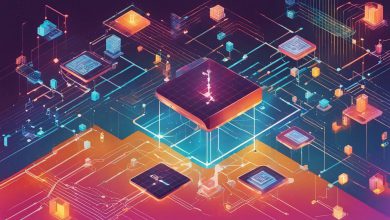
Artificial intelligence (AI) and machine learning (ML) are rapidly becoming the driving force behind unprecedented changes in various industries. From healthcare to finance, manufacturing to retail, AI and ML are transforming the way we live, work, and interact with the world. These innovative technologies are setting the stage for a new era, where machines can process and analyze vast amounts of data, enabling intelligent decision-making, and automation.
As we enter this new era, it is essential to understand the capabilities of AI and ML technology. These technologies are not just buzzwords but powerful tools for data analysis, pattern recognition, and prediction. They can process information at a speed and scale that is beyond human capacity, enabling us to gain new insights and create innovative solutions.
Through this article, we’ll explore the impact of AI and ML on various sectors, highlighting the challenges and opportunities that arise with increased adoption. We’ll delve into how these technologies are revolutionizing patient care, diagnosis, treatment, and drug discovery in healthcare. We’ll see how AI and ML are enhancing fraud detection, risk assessment, trading algorithms, and customer service in finance. We’ll examine how these technologies optimize production processes, improve quality control, enable predictive maintenance, and enhance supply chain management in manufacturing. We’ll explore how AI and ML are revolutionizing customer engagement, personalized marketing, inventory management, and demand forecasting in retail.
We are on the cusp of a new industrial revolution, a digital transformation powered by innovative technology. AI and ML are at the forefront, driving this change and enabling new possibilities. Join us as we explore the dawn of a new era and how AI and ML are reshaping industries for the better.
Understanding AI and ML Technology
Artificial Intelligence (AI) and Machine Learning (ML) are transformative technologies that are rapidly reshaping industries across the globe. AI refers to the development of computer systems that can perform tasks that ordinarily require human intelligence. On the other hand, ML is a subset of AI that uses statistical techniques to enable computer systems to learn from data, without being explicitly programmed.
AI technology exploits deep learning networks, natural language processing, and predictive analytics to facilitate recommended actions or even autonomous decision-making. ML solutions, on the other hand, use data, algorithms, and models to improve their accuracy and achieve higher performance over time. With AI and ML technology, vast amounts of data can be processed and analyzed, enabling intelligent decision-making and automation.
AI and ML technology are being used to solve complex problems and make mundane tasks more manageable. The applications of AI and ML are endless, ranging from virtual assistants like Siri and Alexa to self-driving cars and drones. In addition, their impact can be seen across various industries, including healthcare, finance, manufacturing, and retail.
AI and ML in Healthcare
The healthcare industry is one of the sectors significantly impacted by the transformative power of AI and ML. These innovative technologies are helping reshape the industry by enhancing patient care, improving diagnoses, and revolutionizing drug discovery and treatment.
AI and ML algorithms can analyze vast amounts of medical data, including patient records, medical images, and genomic data, at unprecedented levels of speed and accuracy. This capability enables medical professionals to identify potential health risks, develop personalized treatment plans, and optimize healthcare outcomes.
AI-powered chatbots and virtual assistants are also revolutionizing patient care by streamlining appointments, providing personalized follow-up care, and answering patient questions instantly. These technologies are helping to reduce the burden on healthcare workers while enhancing patient satisfaction.
Moreover, AI and ML are transforming drug discovery and development by expediting the process of identifying potential drug candidates, reducing the likelihood of adverse effects, and improving outcomes. AI algorithms can analyze vast amounts of data from clinical trials and medical research, predicting how different compounds will interact with the body and identifying potential risks.
However, the adoption of AI and ML in healthcare also presents potential ethical and regulatory concerns, including privacy violations, data security, and legal liability. As such, it is essential to balance the potential benefits of these technologies with the need for responsible implementation.
AI and ML in Finance
The finance industry is no stranger to the potential of artificial intelligence and machine learning technologies. These innovations are rapidly reshaping the industry, driving new levels of efficiency, accuracy, and customer service.
One area where AI and ML are having a significant impact is fraud detection. By analyzing large volumes of data in real-time, these technologies can quickly identify potential cases of fraud, enabling swift action to prevent losses.
Another important application of AI and ML in finance is risk assessment. These technologies can analyze vast amounts of data to assess creditworthiness, identify potential issues, and recommend appropriate courses of action.
AI and ML are also increasingly used in trading algorithms, where they can analyze market trends, identify opportunities, and execute trades with remarkable speed and accuracy.
| Benefits of AI and ML in Finance | Challenges of AI and ML in Finance |
|---|---|
|
|
As with any new technology, there are challenges and risks associated with the implementation of AI and ML in finance. Privacy and security concerns are a major issue, as are potential job displacement and the difficulty of interpreting and trusting algorithmic decisions. However, the benefits of these technologies are too great to ignore, and we can expect to see continued growth and innovation in this space in the coming years.
AI and ML in Manufacturing
The manufacturing industry has been one of the early adopters of AI and ML, deploying these technologies to optimize and streamline critical processes. By harnessing the power of AI and ML, manufacturers can reduce downtime, improve quality control and increase productivity.
One of the significant applications of AI and ML in manufacturing is predictive maintenance. By analyzing data from sensors, machines, and equipment, AI algorithms can identify potential breakdowns before they occur, thus minimizing unplanned downtime and reducing maintenance costs.
AI and ML are also used to improve product quality by detecting defects and anomalies in real-time. By analyzing production data, machine learning algorithms can identify patterns and correlations that can help optimize production lines, reduce waste, and improve product quality.
Another area where AI and ML are making a significant impact is supply chain management. By analyzing data on inventory levels, sales patterns, and demand forecasts, AI algorithms can help manufacturers optimize inventory levels, reduce stockouts, and improve supplier performance.
Jobs and Workforce Dynamics in Manufacturing
While AI and ML offer tremendous benefits to the manufacturing industry, there are concerns about the impact on jobs and workforce dynamics. As machines become more autonomous and intelligent, there is a risk of displacement of human workers. However, experts believe that AI and ML will create new job opportunities, particularly in areas such as data science, automation engineering, and system integration.
As the manufacturing industry continues to embrace AI and ML, it is essential to address the potential impact on the workforce proactively. This requires a multi-stakeholder approach, involving industry leaders, policymakers, and labor representatives, to ensure a smooth transition to the new era of manufacturing.
AI and ML in Retail
The retail industry is experiencing a significant shift with the advent of AI and ML. These technologies are transforming the way businesses engage with customers, manage inventory, and forecast demand.
AI and ML-powered chatbots and virtual assistants are changing the customer experience, providing personalized recommendations and responding to inquiries. These tools enable retailers to engage customers in a more interactive and efficient way, building trust and loyalty.
Inventory management is also being revolutionized by AI and ML. These technologies allow for more accurate forecasting of demand, optimizing the amount of stock held and reducing waste. This results in significant cost savings and improved customer satisfaction as products are more likely to be in-stock and readily available.
Furthermore, AI and ML are enabling retailers to better analyze data from various channels and sources, providing insights into consumer behavior and preferences. This data can be used to develop targeted marketing campaigns, improve product design, and enhance the overall customer experience.
As with any major technology disruption, the adoption of AI and ML in retail also brings its fair share of challenges. Concerns about data privacy, security, and the displacement of jobs are valid and must be addressed by retailers and policymakers.
Despite the challenges, the potential benefits of AI and ML in retail are numerous. By embracing these innovative technologies, retailers can adapt to changing consumer needs and preferences, remain competitive, and drive growth in the industry.
Conclusion
In conclusion, AI and ML are innovative technologies that are shaping the next industrial revolution and enabling digital transformation across industries. The impact of AI and ML is far-reaching, bringing unprecedented changes and disruptions to traditional business models.
As we have discussed in this article, AI and ML have the potential to revolutionize healthcare, finance, manufacturing, and retail. In healthcare, AI and ML can improve patient care and drug discovery. In finance, AI and ML enhance fraud detection, risk assessment, and trading algorithms. In manufacturing, AI and ML optimize production processes and enhance supply chain management. In retail, AI and ML are enabling personalized marketing and enhancing inventory management.
With these exciting possibilities, there are also challenges that need to be addressed. As AI and ML solutions become more prevalent, there are ethical considerations to be made, such as data privacy and bias. Additionally, the impact on jobs and workforce dynamics is a critical issue that needs to be considered.
Looking Towards the Future
As we look towards the future, it is clear that AI and ML will continue to drive innovation and disruption across sectors. The potential benefits they offer are vast, from improving efficiency and effectiveness to saving lives and enhancing customer experience.
As with any innovative technology, it is important that we use AI and ML responsibly and thoughtfully, with a focus on maximizing the benefits while minimizing the risks. By doing so, we can ensure that the dawn of this new era is one that we all can benefit from.
AI and ML are indeed the key elements of the industrial revolution that we are currently experiencing. They have brought about significant digital transformation that has helped businesses improve their decision-making, enhance productivity and remain competitive in the ever-evolving market. As this article has demonstrated, AI and ML are not only reshaping industries, but are also creating new possibilities in the world of technology.








